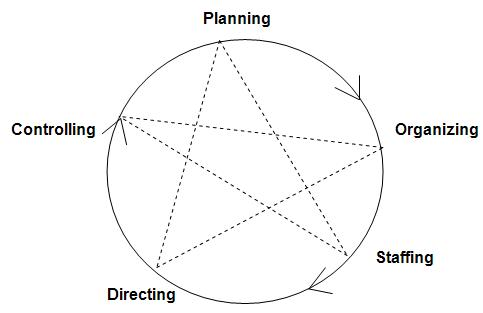Management as a Process
- As a process, management refers to a series of inter – related functions.
- It is the process by which management creates, operates and directs purposive organization through systematic, coordinated and co-operated human efforts.
- According to George R. Terry, “Management is a distinct process consisting of planning, organizing, actuating and controlling, performed to determine and accomplish stated objective by the use of human beings and other resources”.

Planning
- It is the basic function of management.
- It deals with chalking out a future course of action & deciding in advance the most appropriate course of actions for achievement of pre-determined goals.
- According to KOONTZ, “Planning is deciding in advance – what to do, when to do & how to do. It bridges the gap from where we are & where we want to be”.
Organising
- It is the process of bringing together physical, financial and human resources and developing productive relationship amongst them for achievement of organizational goals.
- According to Henry Fayol, “To organize a business is to provide it with everything useful or its functioning i.e. raw material, tools, capital and personnel’s”.
- To organize a business involves determining & providing human and non-human resources to the organizational structure.
- Organizing as a process involves:
- Identification of activities.
- Classification of grouping of activities.
- Assignment of duties.
- Delegation of authority and creation of responsibility.
- Coordinating authority and responsibility relationships.
Staffing
- It is the function of manning the organization structure and keeping it manned.
- Staffing has assumed greater importance in the recent years due to advancement of technology, increase in size of business, complexity of human behavior etc.
- The main purpose o staffing is to put right man on right job i.e. square pegs in square holes and round pegs in round holes.
- According to Koontz & O’Donell, “Managerial function of staffing involves manning the organization structure through proper and effective selection, appraisal & development of personnel to fill the roles designed un the structure”.
Directing
- It is considered life-spark of the enterprise which sets it in motion the action of people because planning, organizing and staffing are the mere preparations for doing the work.
- Direction is that inert-personnel aspect of management which deals directly with influencing, guiding, supervising, motivating sub-ordinate for the achievement of organizational goals.
- Direction has following elements:
- Supervision
- Motivation
- Leadership
Communication
Controlling:
- It implies measurement of accomplishment against the standards and correction of deviation if any to ensure achievement of organizational goals.
- The purpose of controlling is to ensure that everything occurs in conformities with the standards.
- An efficient system of control helps to predict deviations before they actually occur.
- According to Theo Haimann, “Controlling is the process of checking whether or not proper progress is being made towards the objectives and goals and acting if necessary, to correct any deviation”.
Controlling:
- According to Koontz & O’Donell “Controlling is the measurement & correction of performance activities of subordinates in order to make sure that the enterprise objectives and plans desired to obtain them as being accomplished”.
- Therefore controlling has following steps:
- Establishment of standard performance.
- Measurement of actual performance.
- Comparison of actual performance with the standards and finding out deviation if any.
- Corrective action.

